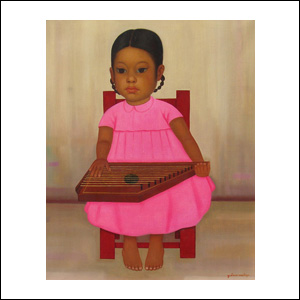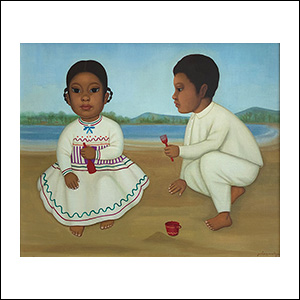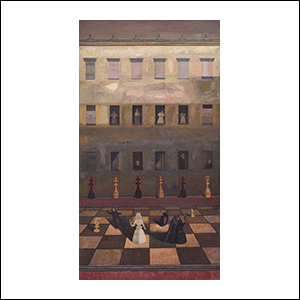Gustavo Montoya
Mexico City, 1905 - Mexico City, 2003
GUSTAVO MONTOYA - BIOGRAPHY
Gustavo Montoya was born in Mexico City on July 9, 1905. At the age of 13 he studied painting at the Academia de San Carlos. Some of his teachers were: German Gedovius, Roberto Montenegro, Leandro Izaguirre, Francisco de la Torre, Mateo Herrera and Juan de Mata Pacheco, among others. He stated that the school had only taught him the technique of art, but not the spirit of it and therefore he considered himself a self-taught artist.
He married his first wife, Luz Saavedra. In 1929 he traveled to Los Angeles, California, where he worked illustrating posters at the West Coast Theaters Co. The couple had a daughter, Rosa Elena Montoya Saavedra. The marriage did not last long, and Gustavo Montoya returned to Mexico in 1933. In 1936 he entered the Escuela Nacional de Artes Plásticas (National School of Visual Arts) as teacher of the color class.
He married a second time to the painter Cordelia Urueta, with whom he moved to Paris in 1938 to study European avant-garde art. He visited museums, galleries, and painters' studios. He toured Switzerland, Italy and England. In 1939, due to the Second World War, Montoya and his wife were forced to leave for New York where they remained for several years. Exhibited at the Alma Reed Gallery.
When they returned to Mexico in 1942, Gustavo Montoya joined the Mexican neo-realist school movement. In 1953 he entered again as a teacher at the Escuela Nacional de Artes Plásticas.
In 1965 Gustavo Montoya and Cordelia Urueta divorced after 26 years of marriage. He was lonely and did not engage in artistic circles. He was a founding member of the League of Revolutionary Writers and Artists along with Cordelia Urueta and others. Also, he was a founding member of the Salón de la Plástica Mexicana.
He spent most of his professional career depicting the streets of Mexico and its inhabitants. He painted still lifes, street scenes, churches, children, women, and markets in Mexico. Montoya preferred to paint the poor and working class, considering them the most authentic class in Mexico City. He liked to do his work in series around one main idea. Some of his series were: The streets of Mexico, Mexican still lifes, Mexican children, Dreams, Walls, Chess, Allegory of transformation, among others.
Gustavo Montoya died on July 12, 2003 in Mexico City, at the age of 98 years.
(Source: 1. Gustavo Montoya, Un mundo Mágico, Museo de Arte Moderno, 2. Gustavo Montoya, Litógrafos Unidos S.A., 1981)
Main Solo Exhibitions
|
1945 Las calles de México, Galería de Arte Mexicano, Mexico City |
|
1951 Naturalezas muertas de Gustavo Montoya, Salón de la Plástica Mexicana, Mexico City |
|
1952 Niños mexicanos, Salón de la Plástica Mexicana, Mexico City |
|
1954 Exposición de óleos de Gustavo Montoya, Salón de la Plástica Mexicana, Mexico City |
|
1955 Sueños, Galería de Arte Mexicano, Mexico City |
|
1958 Gustavo Montoya, Galería Hammer, New York |
|
1962 Muros, Galería Misrachi, Mexico City |
|
1966 Gustavo Montoya, Galería de Coleccionistas, Beverly Hills |
|
1971 Ajedrez, Galería de la Plástica Mexicana, Mexico City |
|
1979 Weintraub Gallery, New York |
|
1980 Bernard Lewin Gallery, Palm Spring, California |
|
1981 Bernard Lewin Gallery, Beverly Hills, California |
|
1982 Un mundo mágico: Gustavo Montoya, Museo de Arte Moderno, Mexico City |
|
1993 Gustavo Montoya, Petróleos Mexicanos, Departamento de Bellas Artes, Mexico City |
|
1997 Gustavo Montoya: Antología, Museo Mural Diego Rivera del Centro Histórico de la Ciudad de México, Mexico City |
|
1997 Gustavo Montoya: Homenaje al pintor y maestro, Escuela Nacional de Artes Plásticas, Plantel Academia de San Carlos, Mexico City |















